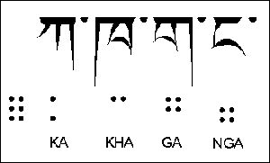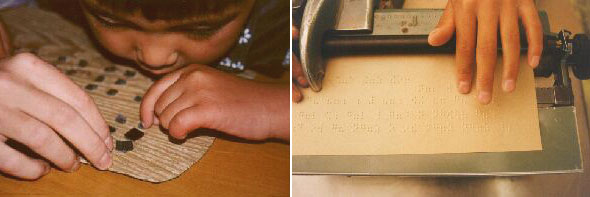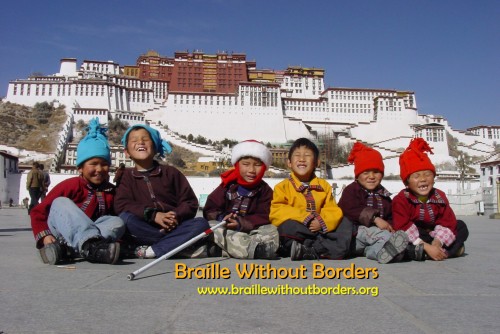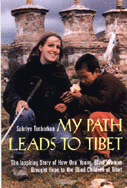|
Click to make font larger
Click to make font smaller
INTRODUCTION
Before the opening of the Project, blind children in the Tibet
Autonomous Region did not have access to education. They led a life on
the margin of society with few chances of integration. According to
official statistics 30.000 of the 2.5 million inhabitants of the T.A.R.
are blind or highly visually impaired. Compared to most areas in the
world this
is well above the average ratio. The causes of visual impairment or
blindness are both climatic and hygienic: dust, wind, high ultra-violet
light radiation, soot in houses caused by heating with coal and/or yak
dung, and lack of vitamin A at an early age. Inadequate medical care
also plays a role.
Cataracts are widespread. Indeed governmental and private organizations
have set up eye-camps where medical surgery is being performed and
local
doctors are taught to do the procedure. However, there is a large group
of blind people that can't be helped this way. For this group of people
the rehabilitation and training centre for the blind, has been
established.
HISTORY
In the summer of 1997 Sabriye Tenberken, blind herself, travelled
within the T.A.R to investigate the possibility of providing training
for Tibetan blind and visually impaired people. Sabriye realised there
were no programs educating and rehabilitating blind people within the
T.A.R. She then took the initiative to found the present project. For
the start of the project she received help from a local school in Lhasa
which provided space. A local counterpart took care of all the
official paperwork.

Part of the Tibetan Braille
script developed by Sabriye Tenberken in 1992 at the
Friedrich-Willhelms
University, bonn, 1992. |
Initially for her
own use in her study of Tibetology at Bonn university, Sabriye
developed
a Tibetan script for the blind. This script combines the principles of
the Braille system with the special features of the Tibetan
syllable-based
script. This script for the blind was submitted for close examination
to
an eminent Tibetan scholar, who found it to be readily understandable,
simple, and easy to learn. As Tibetans until now had had no script for
the
blind, he suggested to Sabriye that she let blind Tibetans take use of
it. |
First step: preparatory school for blind
children
In May 1998 Sabriye Tenberken (German) and Paul
Kronenberg (Dutch) left Europe to establish the Rehabilitation and
Training Centre for the Blind, Tibet, starting with the preparatory
school for elementary school children. After arranging all the
necessary requirements, 6 children were collected from different
villages to board at the school. The children came from different parts
of the Tibet Autonomous Region and had to get used to each other's
dialects. A local teacher was found and within a couple of days she was
instructed in the Tibetan Braille script. The children learned the
Tibetan Braille alphabet on wooden boards with Velcro dots. They
worked with amazing enthusiasm and within just 6 weeks they knew all
the 30 Tibetan characters and were able to count in three different
languages
(Tibetan, Chinese and English).
background information on some of the children
Tenzin
Tenzin is 14 years old. He comes from a little village within the Lhasa
district. His parents are divorced, and he lives with his mother and
his little brother. Tenzin belongs to the few blind children who were
reasonably well integrated in his village. He has friends and had some
tasks. While his friends were attending school he took care of the
village yaks
and goats. Through Medicines Sans Frontiers (MSF) Tenzin heard about
the
Project for the Blind, Tibet. He wasn't used to washing every day and
the
MSF-hygiene-trainers told him as a joke that only clean blind children
could
attend this school. Ever since he obeyed the hygienic instructions to
wash
daily. He was very
eager to attend the school. Tenzin is a very social and intelligent
child, who after only a few months learned to read and write the
Tibetan, Chinese and English Braillescripts fluently. When we asked him
about future profession plans, his answer was that he wants to study
and he wants
to learn massage and physiotherapy. He started in this class in 2001.
Norbu
Norbu is 14 years old. He comes from a very remote little farming
village close to Shigatse. He has a little vision on his left eye, but
not enough to attend a regular school. Norbu is very playful and likes
ball games or just to run around. He is a fast learner and makes
friends with other children very easily As soon as the training
farm has been established he will start in the cheeseproduction.
Yudon
Yudon is 14 years old. She comes from a farming village close to Lhasa.
Being the youngest of six sisters and brothers she is very independent
in learning and playing. Yudon wants to become a teacher. In October
this year she was integrated into a regular school.
Chile
Chile is 13 years old. He comes from a village in the Drigung area,
about 130 km north east of Lhasa. His parents are poor peasants. He has
one younger sister and within the village he has a lot of friends. He
is the comedian of the school and he loves to sing too. He entertains
everyone around him at all times, in all activities. younger sister and
within the village he has a lot of friends. He is the comedian of the
school
and he loves to sing too. He entertains everyone around him at all
times,
in all activities. He has been trained in the music class was
integrated
in his village in the Oct 2003.
Metoq
Metoq is 15 years old and the oldest in the class. One day when she was
8, she was playing in the fields with some friends when they found a
grenade. While playing withit, it exploded and she lost pretty much
all her eyesight. With the help of glasses she sees a little, but not
enough to attend a regular school. Her parents live north of Lhasa.
Metoq
is the leader of the schoolclass. Early in the morning before classes
officially start, she lines up the other children and exercises the
Tibetan Alphabet. She is very neat and she is a great help for the
housemother and father. Tenzin Metoq was integrated in her home in Oct
2003. She wants to start
a shop together with her mother.

Staff of the training centre
- A housemother and a housefather and a gatekeeper are
employed.
They take care
of the children at all times, except when the children attend
classes.
- A cook prepares all the meals for the
children and the staff.
- Three teachers have been trained by
Sabriye Tenberken to teach the children the Tibetan, Chinese
and English Braille systems, and in addition they also
teach mathematics, orientation and daily living skills. An
additional English-teacher has been employed. He became blind
through an accident and was trained by the first three
teachers.
- In autumn 2000 two blind massage trainers
started the massage and physiotherapy-training with two students
who will later become teacher for the massage-training
centre.
- Since March 2001 a famous blind musician
took over the music-classes. He is training 4 talented students to
become professional singers.
- In 2002 one staffmember has been employed to
pruduce Braille school books.
Leisure time
- The children love to play ball games. The
ball is filled with a few rice grains or a small bell, so the
children hear where the ball is.
- Sculpturing tsampa is a very important
way of training the sensitivity of fingertips and
hands. Tsampa is the main traditional food in Tibet, it is made
out of roasted barley mixed with yak butter. It is also
often used as a material to mould sculptures.
- All of the children love to sing and
dance. Now they have also discovered the fun of playing musical
instruments, such as drums, flutes and bells. Apparently any
instrument that produces a lot of noise is welcome.
- The children regularly paint.
- The children like to write stories and
like to play theatre plays.

1. Preparatory school for the Blind
Since the population of blind people in the T.A.R. is very widespread,
it has been decided to have the blind children boarded in Lhasa and be
trained at the centre. From a financial, organisational and logistic
perspective it would simply be too complicated to set up an individual
training program in the very remote areas. With blind people boarding
at the school, training and education can be given much more
effectively. Being taken out of their familiar surroundings for a
certain period of time, they will have to
adjust to a new environment. This helps them to accept and learn the
techniques for the blind more easily. Additionally the blind
have the opportunity to communicate with other blind people and
exchange
experiences and the problems they face in their respective home
situations.
During their one or two years of training, they hopefully will gain
enough
self-confidence to cope with daily life independently. The preparatory
school for the Blind will provide classes and housing for children aged
between 5 and 15. The training for the students will last for one
to two years. At first the students receive an intensive training in
orientation,
mobility and daily living skills (orientation in a room / school
compound,
walking with a cane, eating with chopsticks and daily hygienic skills)
followed by a training in the Tibetan, Chinese, English and
mathematical
Braille script. In addition to the training of the special techniques
for
the blind, the students will also be taught in basic colloquial Chinese
and English language skills. All students who attend a regular school
after
a one or two year's training will be introduced to schoolbooks which
are
used in the first four elementary school classes. The goal of the
preparatory
school is that after completion of the basic training the young
students
will be integrated into regular local elementary schools.
2. Vocational / skills training
The following are possible professions or skills that can be
performed by blind
people in the T.A.R.:
- Tibetan and Chinese medical massage,
pulse diagnosis, acupressure: The professions of
medical masseur and physiotherapist are within the PR China
reserved for the blind and the deaf. Two blind in
Chengdu educated medical massage trainers were found who
started up this program in the autumn of 2000. In May
2001 , April 2002 and April 2003a blind physiotherapist from
Switzerland, Monique Assal, came to Lhasa to train the trainees
and one massage btrainer in the basics of physiotherapy.
- Musical training: especially talented
blind students are trained by a professional musician in singing,
composing and playing musical instruments.
- Animal husbandry: Milk, yoghurt, cheese
production (Summer 2004)
- Agriculture: Cultivating vegetable and
grain. (Summer 2004)
- Handicrafts: Knitting, weaving, pottery,
carpentry , basket making. (Summer 2004)
- In the centre in Lhasa the students are trained in
the use of a computer.
3. A workshop for the production of educational
school materials.
To provide reading and working materials for the students attending the
school and the vocational training program, a workshop for the
production of Tibetan Braille materials has been established. A
computer program to convert written Tibetan into Tibetan Braille has
been developed by a German blind mathematician, Eberhard Hahn. Tibetan
texts can be typed into a computer through Wylie transliteration, and
the program converts this transliteration into Tibetan Braille, which
is then printed in Braille. The first Tibetan Braille books were
produced in August 2001.
4. Self-Integration Project
Only shortly after the project started it showed that the impact of the
project on the students was a very positive one. Children who
came from backgrounds in which they were completely excluded from
society discovered that they were not the only ones with a similar
fate. The students were able to share their experiences and they were
confronted with blind people who were able to perform different tasks
and professions. All students were treated the same. Within days the
students grew stronger and also their
self confidence increased considerably. In case a student mentioned
that
he couldn’t do a certain task, the teachers and staff of the project
replied
telling them that the blind teachers or Sabriye was able to perform the
task
and they also could not see. Within the project the students showed
that
their increasing self confidence was a very important step to be able
to
face the daily society. One day, a few of the students walked in the
centre
of Lhasa and some Nomads very rudely shouted at them: ”Hey, you blind
fools!!”. Kienzen, the oldest of the small group turned around and told
the nomad
that yes, he is blind but he is not a fool. “I am going to school, I
can
read and write! Can you do that?”. “I can even read and write in the
dark!
Can you do that?”The nomads were very astonished and of course they
were
not able to write because they never visited a school. They started a
conversation and about 6 months later these nomads brought a blind
little boy from
their region to the project. This small example shows how important it
is for the children to know that they are valuable members in society.
We want the students not to be embarrassed to be blind, they should see
it as a sort of quality. One person has big feet, another hasred hair
and some are blind. They should stand up in society and say, “I am
blind, so what!?”.
In the Tibetan society it is believed that blindness is a punishment
for something done wrong in a previous life. Because of a lot of media
attention in the TAR the project is being visited by lots of Tibetan
and Chinese people who are curious to see what is going on there. When
they are confronted with happy children they wonder how it can be that
these
children are punished. It is the staff who tells them that these
children are not punished but they are challenged for their next
life.The
visitors seem to be very open for this idea and suddenly they see the
blind
with some more respect.

Initially BWB planned to train special fieldworkers
to counsel the students on a regular base. In the beginning BWB
received
help from some Save the Children staff members who were visiting the
school
nearly every week anyway. However after a few months BWB noticed that
the
students were doing really well and that they integrated themselves
into
their class and school. BWB gave this some thought and realized that
the
process cannot be called RE-INTEGRATION since the children have never
been
integrated before. The process also cannot call it just INTEGRATION
since
what does that mean? If you put blind students in a regular elementary
school
does that mean they are integrated. What happens to them during the
breaks?
Do they have friends? How do the teachers treat them? What about the
surrounding
environment of the school? The trained blind students showed their
surrounding
what they are capable of, where they need help and where they are able
to
help the sighted children. BWB saw that they made a lot of friends but
also
met some competitors in class which shows that the integration is real
and
that the blind do not get a special treatment. BWB therefore came to
the
term “SELF-Integration” to describe the process. The children
have
a base of knowledge and most important enough self-confidence to be
able
to
integrate themselves into the school, daily society and also
into a profession. Two students, Kyla and Digi, who followed the
medical
massage and physiotherapy training, graduated in November 2003 and in
December they started their own clinic. Dorjee and Jampa, the twins
start
their own teahouse. BWB will be in touch with the self-integrated
students
on a regular base to supply the studentswith Braille schoolbooks, paper
and other needed materials.
All Contents
Copyright ę2005 Braille Without Borders All Rights Reserved.
Web site sponsored by National Importers Inc.
Web Design sponsored by Summa Systems Ltd.
|





